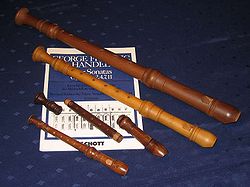
Back Blockflöte ALS ريكوردر Arabic Flauta duce AST Блокфлейта Bulgarian Flauta dolça Catalan ڕیکۆردەر (ئامێری مۆسیقا) CKB Zobcová flétna Czech Blokfløjte Danish Blockflöte German Bekfluto Esperanto
 Various recorders (second from the bottom disassembled into its three parts) | |
| Woodwind | |
|---|---|
| Other names | See § Other languages |
| Classification | |
| Hornbostel–Sachs classification | 421.221.12 (Flute with internal duct and finger holes) |
| Playing range | |
Soprano recorder: C5–D7(G7) | |
| Related instruments | |
| Musicians | |
| Recorder players | |
The recorder is a family of woodwind musical instruments in the group known as internal duct flutes: flutes with a whistle mouthpiece, also known as fipple flutes. A recorder can be distinguished from other duct flutes by the presence of a thumb-hole for the upper hand and seven finger-holes: three for the upper hand and four for the lower. It is the most prominent duct flute in the western classical tradition.[1]
Recorders are made in various sizes with names and compasses roughly corresponding to various vocal ranges. The sizes most commonly in use today are the soprano (also known as descant, lowest note C5), alto (also known as treble, lowest note F4), tenor (lowest note C4), and bass (lowest note F3). Recorders were traditionally constructed from wood or ivory. Modern professional instruments are almost invariably of wood, often boxwood; student and scholastic recorders are commonly of moulded plastic. The recorders' internal and external proportions vary, but the bore is generally reverse conical (i.e. tapering towards the foot) to cylindrical, and all recorder fingering systems make extensive use of forked fingerings.
The recorder is first documented in Europe in the Middle Ages, and continued to enjoy wide popularity in the Renaissance and Baroque periods, but was little used in the Classical and Romantic periods. It was revived in the twentieth century as part of the historically informed performance movement, and became a popular amateur and educational instrument. Composers who have written for the recorder include Monteverdi, Lully, Purcell, Handel, Vivaldi, Telemann, Bach, Hindemith, and Berio.[2] There are many professional recorder players who demonstrate the full solo range of the instrument, and a large community of amateurs.[3]
The sound of the recorder is often described as clear and sweet,[2] and has historically been associated with birds and shepherds. It is notable for its quick response and its corresponding ability to produce a wide variety of articulations. This ability, coupled with its open finger holes, allow it to produce a wide variety of tone colours and special effects. Acoustically, its tone is relatively pure and, when the edge is positioned in the center of the airjet, odd harmonics predominate in its sound (when the edge is decidedly off-center, an even distribution of harmonics occurs).[4][2]
- ^ Montagu, Jeremy. "Duct flute". Grove Music Online. Oxford University Press. Retrieved 6 February 2016.[permanent dead link]
- ^ a b c Lasocki, David. "Recorder". Grove Music Online. Oxford University Press. Archived from the original on 25 May 2012. Retrieved 6 February 2016.
- ^ For example, Eve O'Kelly describes how Frans Brüggen "achieved worldwide recognition as a recorder virtuoso" in her book The Recorder Today, Cambridge University Press, 1990. ISBN 0-521-36681-X. p. 62
- ^ Bonard, Jean-Marc (January 2001), "The Physicist's Guide to the Orchestra", European Journal of Physics, 22 (1): 89–101, arXiv:physics/0008053, Bibcode:2001EJPh...22...89B, doi:10.1088/0143-0807/22/1/309, S2CID 13835513
© MMXXIII Rich X Search. We shall prevail. All rights reserved. Rich X Search